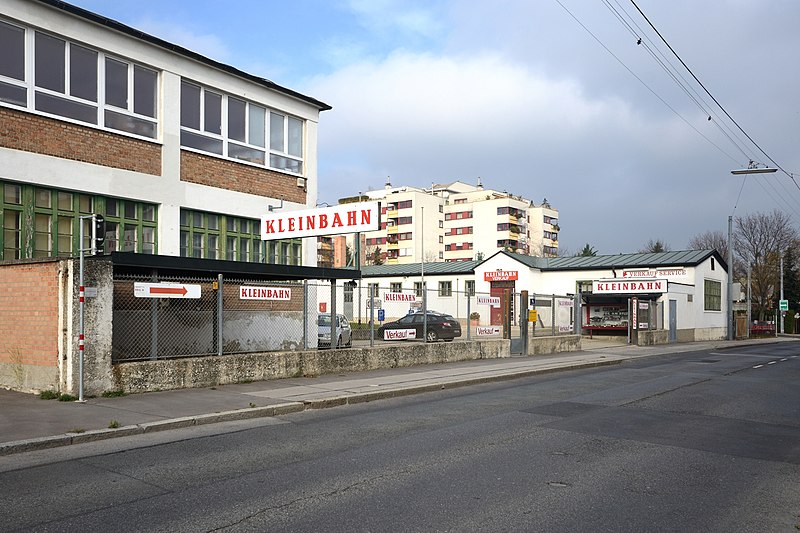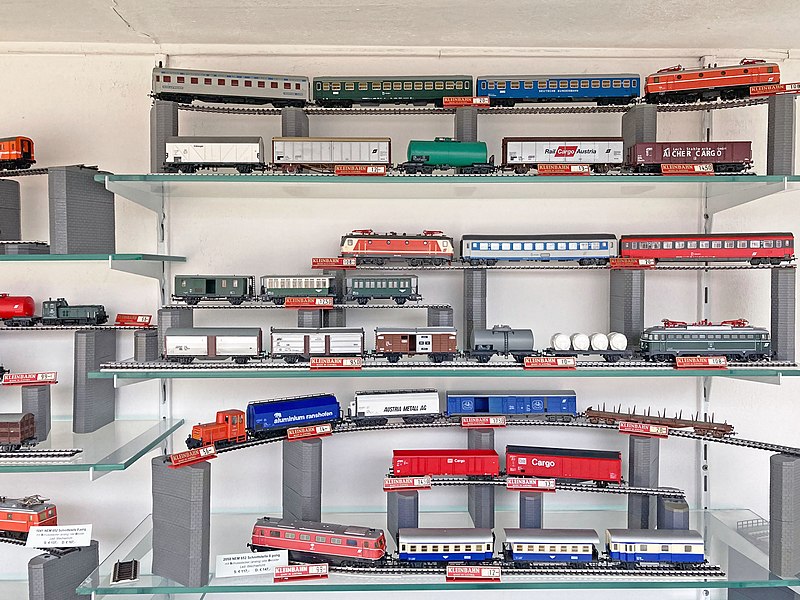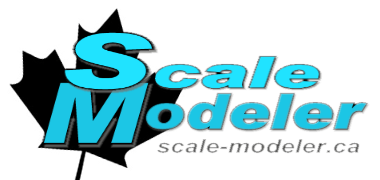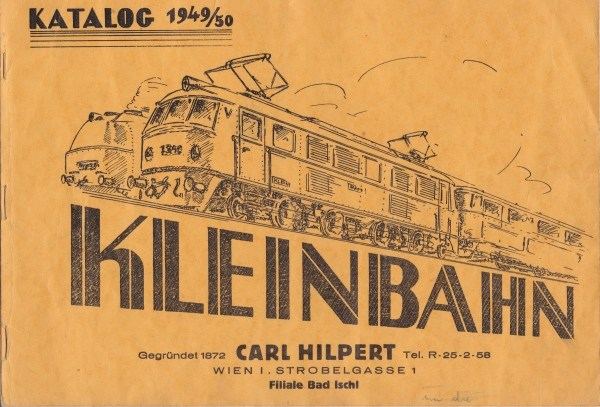

Kleinbahn was a term used in Prussia in the late 19th century to describe a legal class of light or small railway. Then in the 20th century Kleinbahn came to mean an Austrian toy manufacturer synonymous with model trains, producing economically priced mid-range quality HO scale (1:87) complete train systems from 1947 through to 2021.
Kleinbahn eschewed extreme detail and sophistication for a simpler and more robust product and in its early years lead the model train world with several innovations. But with just two foreign (Swiss) retail channels and limited focus on their online presence Kleinbahn remained one of Austria’s best kept secrets. Some suggest that Kleinbahn’s reluctance to use newer, smaller and cheaper components from 3rd party vendors and their insistence on manufacturing everything in house eventually led to their own demise. Competing interests split the company. Kleinbahn soldiered on but increased foreign competition and their own reluctance to adapt finally overcame the small family owned company.
For a young boy growing up in my generation just as Scalextric was to toy slot cars for an English schoolboy so to was Kleinbahn to toy trains for every young Austrian – or at least that is what I was told… As someone with Austrian roots I always looked forward to family trips to Austria when I could finally visit the Kleinbahn store and quickly spend my saved allowance. Eventually my collection would grow to include a modest selection of stuff with which to build my first ‘Kleinbahn’.
A Little History of Kleinbahn

Translated from their abandoned website:
In 1947 Erich Klein introduced his first model railway collection at the Viennese Autumn Trade Fair. His basic philosophy was to produce solid and robust quality at an advantageous price.KLEINBAHN produced a complete model railroad collection for the Austrian market. Then as now KLEINBAHN remains faithful to this philosophy continuing production in the 23rd District of Vienna, Atzgersdorf, using high quality materials in an environmentally friendly way. KLEINBAHN manufactures not only engines powered by steam, electricity and diesel but also passenger carriages and freight wagons. The KLEINBAHN collection is rounded off by all elements of a model railway set including bridges, catenary, buildings and much more. Our knowledgeable sales staff are at your disposal to give you free advice in all of our stores.1947 KLEINBAHN was founded by Erich Klein producing the first toy trains out of wood, tin and cardboard.1950 KLEINBAHN produced the first plastic wagon.1951 Erich Klein patented KLEINBAHN as a protected brand name at the Austrian Patents Office with patent number 21.572. KLEINBAHN introduced a track system on plastic ballast (white tracks).1952 Erich Klein's brother Oskar Klein joins as partner in the new company KLEINBAHN Mechanische Werkstätte, Spielwarenerzeugung, Brüder KLEIN OHG.1955 On December 1st KLEINBAHN's inventory was sold out for the year! The price of the fully operational KLEINBAHN starter-set was reduced from ATS 295,- to 195!1957 KLEINBAHN produces the first track system with plastic sleepers (worldwide).1959 KLEINBAHN produces the first passenger carriage with interior furnishings.1961 KLEINBAHN introduces coloured windows.1966 KLEINBAHN integrates corner windows.1967 KLEINBAHN produces a steam engine with transparent boiler.1972 KLEINBAHN produces a table top turntable just 10mm high.1984 The company Brüder Klein OHG dissolved at the request of Erich's brother Oskar. Erich Klein returns to the original company KLEINBAHN, Mechanische Werkstätte, Spielwarenerzeugung, Ing. Erich Klein. KLEINBAHN opens a store in Linz, Coulinstraße 15.1985 KLEINBAHN opens a store in Vienna 22, Wagramerstraße 98.1998 KLEINBAHN opens a store in Salzburg, Griesgasse 2A.2007 The 60th Anniversary of KLEINBAHN. Company transfered to daughter Angelika Pfneisl. KLEINBAHN re-opens the store in Klagenfurt, Bahnhofstraße 24. A World Record! At the International Model Fair in Vienna 9 KLEINBAHN-engines pull 1301 wagons a distance of over 1km.2008 KLEINBAHN re-opens the store in Salzburg, Griesgasse 2A. KLEINBAHN opens a store in Bregenz, Bahnhofstraße 9.2009 KLEINBAHN introduces a limited edition SURPRISE PACKAGE (the first made up of the limited series of "Graffiti" Wagons).2010 On February 16 KLEINBAHN receives a special stamp in the Postal Stamp Series "Classical Brands" and releases a limited edition of 500 wagons with certificate.2011 KLEINBAHN opens a new flagship store in Vienna, A-1010 Wien, Schottenring 17. KLEINBAHN introduces an online shop for easier and convenient sales over the Internet.2015 KLEINBAHN transferred to the son M. Pfneisl.We contribute to environmental protection:Visit the Kleinbahn website by clicking here.
KLEINBAHN has consciously manufactured rationally and in an environmentally friendly way for over 60 years.
Our packaging material is principally made out of paper and cardboard.
In 2021 Kleinbahn left the following message for its website visitors (German version):
Dear valued customers!Visit the Kleinbahn website by clicking here.
Since July 19th, 2021 our shop, postal service and online shop have been closed.
We would like to thank you very much for the years of loyalty and the trust you have placed in us.
Please do not register in the shop anymore!!!
Now for a much more thorough account of Kleinbahn from Wikipedia:
The company Kleinbahn (official name KLEINBAHN mechanical workshop – toy production Ing. Erich Klein e.U. ) was an Austrian full-range manufacturer of model railways of the nominal size H0 . Kleinbahn products were only available through the company’s own production facilities and mail order.
Originally founded in 1947, in 1984 the company was split into the Kleinbahn and Klein Modellbahn companies . The company stopped production in 2021.
History
The company was founded in 1947 on the Währinger Gurtel in Vienna by Erich Klein (born 1923), a precision mechanic trained at Schrack AG . Initially, ships and airplanes were made of wood. In May 1948, the brother and qualified electrical engineer Oskar Klein joined the company. [2] At the suggestion of the toy dealer Carl Hilpert , model railways were added to the range from the Vienna Autumn Fair in 1948. The first vehicles were largely made by hand from lead, tin and wood. [2] [3] A mold maker of Augarten porcelain Erich Klein built the first molds for the lead-cast locomotive housing. [4]
The three of them made and sold the products in a small basement workshop measuring just 10 square meters. [3] [5] [4] Initially, small electric motors from Wehrmacht stocks (so-called “Wehrmachtsmotore”) were used in the vehicles. The Klein brothers thus brought the first model railway in H0 gauge to the market with the two-wire direct current system that is dominant today. Kleinbahn was also the first manufacturer to produce vehicles made of plastic from 1950, but none of these innovations were patented. [2]Erich Klein received the plastic granules from the American occupiers at a price of one shilling per kilogram, the first kilo allegedly in exchange for a bottle of wine. [4]
In March 1951, the Kleinbahn brand name was legally protected, and since October 1, 1952, the company was a general partnership under the name Gebrüder Klein OHG. The partnership agreement was limited to 30 years. [2] After several relocations (among other things, production was also carried out in the later shop on Schottenring) production began in 1955 in the former David Langfelder shoe factory on Gatterederstraße in Vienna-Atzgersdorf, which was the company location until the end. [6] [3]
The product range was mainly aimed at the Austrian market, since ÖBB models were hardly available from the dominant German model railway manufacturers. Making model railways affordable for everyone through cost-effective production was another goal of the company’s philosophy. Erich Klein was referring to none other than his role model, Henry Ford . [3] This philosophy included simplified models and the use of plastic in injection molding technology from 1953, the Klein brothers constructed their first injection molding machine themselves. [2]
At Christmas 1955, the price for a starter set was reduced to 195 schillings, which was a great sales success. The products were actually so widespread that the name “Kleinbahn” became a generic name for H0-scale model railways in Austria. At times, up to 250 people were employed in the factory, Kleinbahn (according to its own definition) became Austria’s largest toy factory. [2] [3] In the mid-1950s, the traditional sports and toy store Anton C. Niessner, founded in 1852 , at Kirchengasse 9 in Vienna-Mariahilf was taken over. [7] [8]At this location at the corner of Lindengasse/Kirchengasse there was a well-known Kleinbahn branch until 2009.
From the beginning there was great competition with the Vienna-based producer Liliput , which allegedly even culminated in mutual industrial espionage, bribery and physical violence between the company bosses Erich Klein and Walter Bucherl (about the model of the fictitious “Red Arrow”). [2] [6] [4]
A special feature of the company policy from 1955 was the lack of a sales network. Kleinbahn models were only offered in Kleinbahn branches and via the postal service, which saved the margin for the intermediate trade. At its peak there were ten branches in almost all provincial capitals and Lienz . At times there were even branches in Zurich and Basel , some models based on the SBB model enriched the range and there was a Swiss subsidiary called Brüder Klein AG . [9] [10] [11] In 1962 the company employed around 200 people. [5]At the beginning of the 1960s, Kleinbahn – as the first model railway manufacturer ever – used perfectly fitting, clear windows and interior fittings for the vehicles. This innovation was not patented either, so there was a patent dispute with the Nuremberg company Gebrüder Fleischmann . [2]
In the first recession after the war, in the 1970s, the company’s success began to stagnate. Production and new developments were noticeably reduced for a few years, and it was not until 1976 that a new development came out with the ÖBB 4010 . [2] From 1979, due to increasing differences between the Klein brothers, the Klein brothers no among themselves. [2]
From 1984 to 2008, two model railway manufacturers had their headquarters at the old location:
- Erich Klein continued to run the Kleinbahn company , mechanical workshop – toy production Ing. Erich Klein with the previous market orientation of inexpensive products. In the meantime, the company has been taken over and continued by his daughter. So e.g. For example, the long-distance coach has already been reissued in the current ÖBB design.
- Oskar Klein (senior) now called his company Klein Modellbahn GesmbH . After the senior’s death, his son Oskar Klein jun. the company focused on higher-quality, true-to-original products, but still sold the old range. After financial difficulties and attempted restructuring, the company ceased production at the end of July 2008. [12] Remaining stocks were sold until the end of 2010, Oskar Klein jun. passed away in October 2020.
In 2007, the company was handed over to the daughter of Angelika Pfneisl, who continued to run it, and a number of innovations followed. In most cases, however, these were color variants of existing models. In February 2010, the Austrian Post issued a 55 cent special stamp “Kleinbahn” showing a picture from the main catalog 1958/59. [13] Since the Vienna model building fair in 2010, Kleinbahn has also offered several locomotives with a digital interface or a built-in digital decoder . The decoders were purchased from Uhlenbrock Elektronik .
On June 24, 2011, the company founder, Ing. Erich Klein, died at the age of 87. [14] In 2015, Angelika Pfneisl handed over the company to her son Matthias. [15] In September 2018, the last branch in Vienna, the traditional former “ flagship store ” at Wiener Schottenring 17, was closed. [16] Since then, the models have only been available at the production site in Vienna’s Gatterederstraße or via the website and mail order.
The postal service and online shop have been closed since January 15, 2021. The shop in Vienna, at Gatterederstraße 4, remained open from Monday to Saturday. [17] [18] After the sale began on July 5, Kleinbahn also closed the sales outlet (yard sale) at the production facility at Gatterederstraße 4 in Vienna on July 17, 2021 and thus finally closed its doors after 74 years. [19] The 6,521 square meter company premises were sold by the owner family to the Linz-based construction company Swietelsky in May 2021 for 14.9 million euros . [20] Demolition of the area began on April 14, 2022.
Product Range
For a long time, it was typical of Kleinbahn that a complete range of model railways was produced in-house.
The product range included locomotives and rolling stock in the H0 nominal size in the two-rail system , mainly of the Austrian Federal Railways (ÖBB) and the Swiss Federal Railways (SBB), as well as a number of accessories. There were also a few German, French and Italian wagons, some of which were identical in shape to Austrian vehicles. The vehicles were manufactured in a simple but robust design, but their proportions were mostly not implemented to scale. In terms of length, Kleinbahn models have traditionally been greatly shortened. For example, in the case of passenger coaches with an original length of 26.4 m, the length scale is 1:113 instead of the usual length scale of 1:100 (slightly shortened) or 1:87 (correct). Some of the vehicles were greatly simplified in their appearance, handlebars and lines were traditionally injection molded onto the housing. It wasn’t until the early 1990s that a few (last) new, near-scale models came out as mold innovations.ÖBB 5147 . [6]
Technically, however, most of the vehicles were at the level of the late 1960s. Until recently, each locomotive or railcar had its own motor for each bogie (see gallery) and a drive via worm and spur gears, other manufacturers had long since switched to the so-called mid-motor concept with drive via cardan shafts. From 1955 to 1985 a permanent magnet motor manufactured by Kleinbahn itself was used. For this somewhat bulky, but quite indestructible motor z. T. the cabs of steam locomotives (ÖBB 156, ÖBB 93 etc.) are shown enlarged. From the 1980s, Mabuchi and Bühler motors were installed. [6]For a long time, the buyer segment included hobby newcomers and cost-conscious model railroaders. A complete set of Eras I to V could be put together for just 100 euros (as of 2015).
The Blue Lightning (ÖBB 5045), a model of the ÖBB 12 express train steam locomotive manufactured in the 1960s, as well as the E499.0 locomotive of the Czechoslovak State Railways ČSD and the E 424 of the Ferrovie dello Stato are considered sought-after collectors’ items from earlier production years . The E499.0 of the CSD was for a long time the only model of an Eastern Block locomotive from a Western manufacturer. [6]
The simple construction of the locomotives still leaves enough space inside for a locomotive decoder , so that they are well suited for subsequent digitization. An increasing number of locomotives were recently offered in three variants: analogue, digitally prepared (socket for plugging in the decoder provided with a shorting plug) and digital. Decoders and products from Uhlenbrock Elektronik were offered here. The electric locomotives can all optionally be operated via the overhead line (changeover switch on the underside or as a changeover plug on the roof), which has already allowed independent two-train operation on one track in analog operation.
The model rails had a hollow profile with a height of 2.6 mm, which was mounted on plastic sleepers and were connected using wire pins. Although this type of connection is invisible, it also entails contact problems. The Kleinbahn program therefore included a special contact oil that prevents the rails and connecting wires from oxidizing. The range and material has not really changed since the 1970s. There were also only two middle curve radii (385 and 436 mm), but also meter track in “flexible” and “less flexible” versions. Signals, catenary , switches and a turntable were also addedoffered from our own production. However, the overhead line masts were lattice masts and no longer corresponded to ÖBB’s concrete masts today. However, similar masts stood for a long time on early electrified lines such as the Arlbergbahn or Salzkammergutbahn . The daylight signals have now been adapted to the current ÖBB version and equipped with LEDs. In 2012, dwarf shunting signals came out as one of the latest innovations, actually a rarity in comparison.
Two types of model cars ( Mercedes-Benz /8 and a Steyr 90 truck) and some simple model buildings, mainly railway buildings and a settlement house, were also available. Worth mentioning here is the large train station, which is based on the main station in Graz . A special feature was that these building models, unlike usual, were already fully assembled, which is why an ambitious model maker no longer had the opportunity to design the interior.
Until recently, Kleinbahn got by with three-digit order numbers for their products; locomotives were traditionally only referred to with their original series number and alternatively a D or E in front of it. Identical locomotives and wagons with different liveries were listed under the same number, so that the complete name of the product always had to be given when ordering. The products were always packed in simple cardboard boxes without plastic with the company logo on them and the product name on the side covers. The boxes and catalogs were produced in-house for a long time. [3]
For the current Wikipedia article click here.

For historical Kleinbahn Catalogues and Price Lists click here.
Related Links
- Kleinbahn Catalogues from Conrad-Antiquario
- Evolution of Kleinbahn Sectional Track from the Austrian Bahn Museum
- Thread on spare parts in the MoBa train forum.

